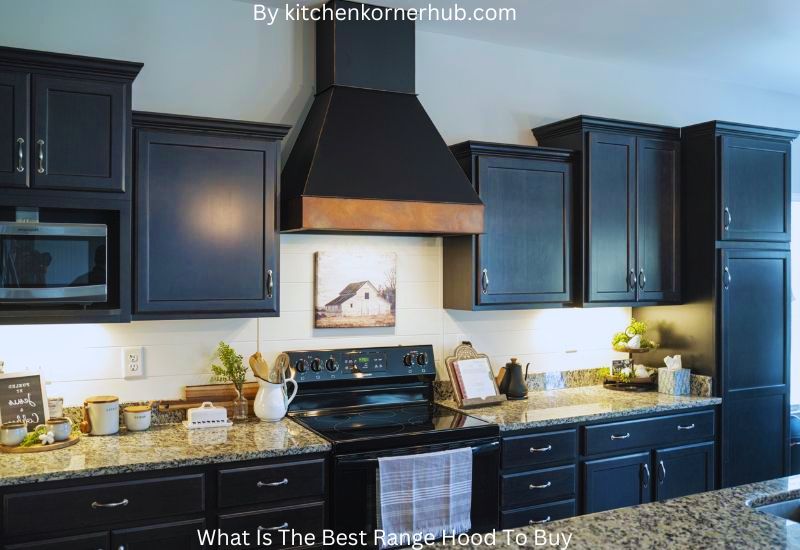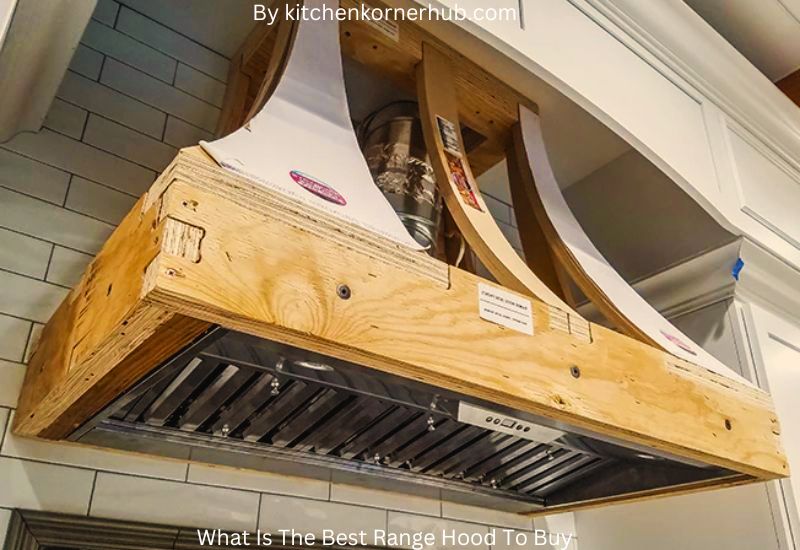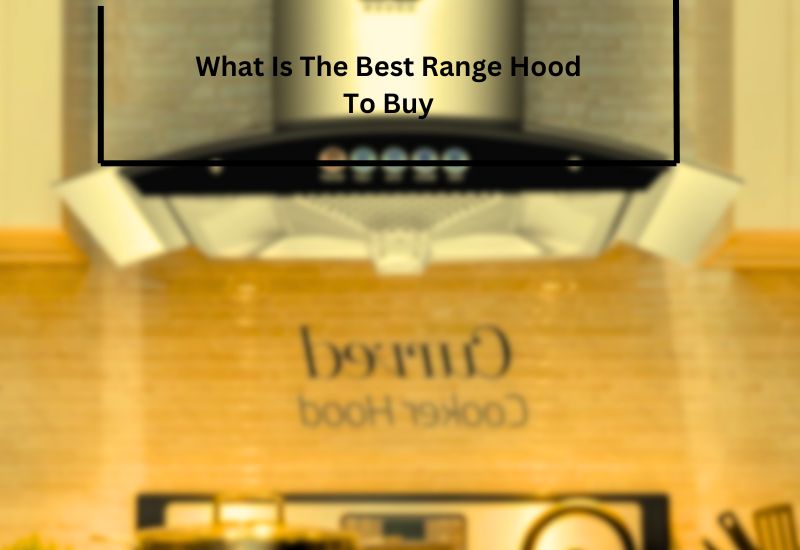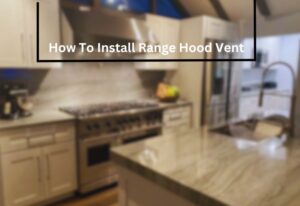If you’re looking to upgrade your kitchen and keep it fresh and odor-free, choosing the right range hood is essential. A range hood might not be the most glamorous item in your kitchen, but it plays a vital role in maintaining air quality and removing cooking odors, smoke, and grease.
What Is The Best Range Hood To Buy? The best range hood to buy depends on your kitchen’s size? cooking habits, and budget. Popular options include the Broan-Nu Tone 413004, Z Line KB-36, and Cosmo COS-5MU30. Prioritize features like airflow capacity, noise levels, and design that suits your needs.
With a variety of options available in the market, finding the best range hood can be a bit overwhelming. But fear not! In this guide, we’ll break down the key factors to consider when selecting a range hood that suits your needs and kitchen space.
Whether you’re an occasional cook or a culinary enthusiast, understanding the types, features, and sizes of range hoods will empower you to make an informed decision for a more comfortable and enjoyable cooking experience.
Key Considerations for Choosing a Range Hood

When it comes to kitchen appliances, the range hood might not be the first thing that comes to mind, but it plays a crucial role in maintaining a clean and odor-free cooking environment.
Choosing the right range hood requires careful consideration of various factors to ensure its effectiveness and compatibility with your kitchen setup. Here are some essential aspects to keep in mind before making your decision.
Ventilation Needs and Kitchen Size
The size of your kitchen and your cooking habits will greatly influence the ventilation needs of your range hood.
If you frequently engage in heavy-duty cooking that involves a lot of frying and grilling, you’ll need a range hood with higher suction power to effectively remove smoke, grease, and odors.
Larger kitchens may require more powerful hoods or even multiple units for comprehensive coverage. On the other hand, smaller kitchens might do well with compact, under-cabinet range hoods.
Ventilation Types
Range hoods come in two main types of ventilation: ducted (vented) and ductless (recirculating). Ducted hoods expel the air and pollutants outside the home, requiring proper ventilation ducts to be installed. Ductless hoods filter the air and release it back into the kitchen after purification.
Ducted hoods are more efficient at removing contaminants, but they require installation and can be costly. Ductless hoods are easier to install but might not be as effective for heavy cooking.
Suction Power and Noise Level
The suction power of a range hood, measured in cubic feet per minute (CFM), determines how effectively it can remove smoke, steam, and odors from your kitchen. Higher CFM ratings are ideal for larger kitchens or those with frequent heavy cooking.
However, with increased suction power often comes increased noise. Consider the noise level of the range hood, especially if you have an open-concept kitchen where the noise could impact your dining or living area.
.Style and Design
Range hoods come in a variety of styles and designs to complement your kitchen’s aesthetics. From sleek stainless steel options to more discreet under-cabinet models, there’s a range hood for every kitchen style.
Island kitchens may benefit from stylish pendant hoods that hang above the cooking area, while wall-mounted hoods are popular choices for traditional setups. Consider how the range hood will blend with your overall kitchen design while maintaining its functionality.
Maintenance and Filters
Regular maintenance is essential to ensure the longevity and efficiency of your range hood. Grease and odor filters in ducted hoods need to be cleaned or replaced periodically to prevent buildup that can reduce performance
. Ductless hoods require filter replacements more often. Some range hoods come with dishwasher-safe filters, making maintenance easier. When choosing a range hood, opt for models with easily accessible and replaceable filters.
Types of Range Hoods: Which One Suits Your Needs?

When it comes to maintaining a clean and well-ventilated kitchen space, a range hood is an indispensable appliance. However, with the multitude of options available, choosing the right type of range hood can be a daunting task. To help you make an informed decision, let’s explore the various types of range hoods and their specific features.
Wall-Mounted Range Hoods: Stylish and Effective
Wall-mounted range hoods are perhaps the most common and versatile type. These hoods are attached directly to the wall above your cooking range. They come in various designs and sizes, making them suitable for different kitchen layouts.
Their effectiveness in removing smoke, odors, and grease is commendable. Additionally, they can serve as stylish focal points in your kitchen, with options ranging from sleek stainless steel to elegant glass canopies.
Under-Cabinet Range Hoods: Space-Saving Solution
Under-cabinet range hoods are a great choice for kitchens with limited space. As the name suggests, these hoods are installed beneath your kitchen cabinets, saving valuable space while efficiently removing cooking fumes.
They are available in various styles and sizes to match your kitchen décor. With their discreet positioning, under-cabinet range hoods offer functionality without compromising aesthetics.
Island Range Hoods: Ideal for Open Kitchen Designs
If you have an open kitchen with a cooking range positioned on an island or peninsula, an island range hood is the perfect solution. Suspended from the ceiling, these hoods effectively capture and expel smoke and odors, ensuring that your open kitchen remains fresh and inviting.
Island range hoods often feature contemporary designs, making them a statement piece in your kitchen.
Downdraft Range Hoods: Sleek and Space-Efficient
For kitchens where traditional ventilation setups might not be feasible, such as in islands or minimalist designs, downdraft range hoods offer a sleek alternative.
These hoods retract when not in use and rise during cooking to efficiently pull down smoke and odors. While they might not be as powerful as some other types, they provide a minimalist and space-efficient solution that blends seamlessly with modern kitchen aesthetics.
Professional Range Hoods: High Performance for Culinary Enthusiasts
Professional range hoods are the choice for serious cooks and culinary enthusiasts who demand top-notch ventilation performance. These hoods are designed to handle the heavy-duty cooking that often takes place in commercial kitchens or by passionate home chefs.
They boast robust extraction capabilities, efficient filtration systems, and durable construction to handle the rigors of frequent and intense cooking.
Top Features to Look for in a Quality Range Hood

A range hood is an essential appliance in any kitchen, not only for its functional benefits but also for the aesthetic enhancement it can bring to the space. When shopping for a range hood, it’s important to consider several key features that contribute to its effectiveness and performance. Here are some top features to look for in a quality range hood:
Ventilation Power and Efficiency:
One of the most crucial factors to consider when selecting a range hood is its ventilation power and efficiency. A high-quality range hood should be capable of effectively removing smoke, grease, odors, and steam generated during cooking.
Look for models with a strong CFM (cubic feet per minute) rating, as this indicates the volume of air the hood can move, and consequently, its ability to swiftly clear the cooking area. Hoods with variable speed settings offer versatility, allowing you to adjust the fan speed based on the cooking task at hand.
Noise Level:
A common concern with range hoods is the noise they produce. While it’s natural for hoods to generate some level of noise due to their powerful ventilation systems, opting for a model with noise-reduction features can significantly enhance your cooking experience.
Look for range hoods that come with sound-absorbing materials, insulated motor housings, and advanced fan blade designs to minimize noise without compromising performance.
Filter Type and Maintenance:
The type of filters used in a range hood plays a vital role in its efficiency and ease of maintenance. Quality range hoods often feature durable and washable baffle filters or mesh filters that capture grease and impurities effectively.
These filters are generally easier to clean and maintain than traditional disposable ones. Additionally, some high-end models include filter indicator lights that remind you when it’s time for cleaning or replacement, ensuring consistent performance.
Lighting Options:
Good lighting is essential while cooking, and many quality range hoods incorporate effective lighting solutions. Look for hoods with energy-efficient LED lights that illuminate your cooktop area evenly, enhancing visibility and creating an appealing ambiance in your kitchen. Some advanced models even offer adjustable brightness settings, allowing you to customize the lighting intensity according to your needs.
Design and Aesthetics:
Apart from functionality, the design and aesthetics of a range hood can significantly impact the overall look of your kitchen. Choose a model that complements your kitchen’s style and decor.
Stainless steel range hoods are popular for their modern and sleek appearance, while custom-panel options allow you to integrate the hood seamlessly with your cabinetry. Some range hoods also feature decorative elements like glass canopies or intricate designs, adding a touch of elegance to the space.
Comparing Ducted vs. Ductless Range Hoods

When it comes to choosing the right range hood for your kitchen, one crucial decision you’ll need to make is whether to opt for a ducted or ductless range hood. Both types have their own advantages and disadvantages, catering to different needs and preferences
. Understanding the key differences between these two options can help you make an informed decision that aligns with your kitchen’s requirements and your cooking habits.
Efficiency and Ventilation
Ducted range hoods, often referred to as vented or exhaust hoods, are known for their superior efficiency in removing smoke, odors, and airborne particles from your kitchen. They function by extracting air from the cooking area and expelling it outdoors through a duct system.
This results in better ventilation, preventing the buildup of greasy residue on surfaces. On the other hand, ductless range hoods use filters to capture and recirculate air back into the kitchen after removing impurities. While they offer convenience by not requiring an external duct, their efficiency in removing all cooking byproducts might be slightly compromised.
Installation and Complexity
Ducted range hoods generally involve a more complex installation process due to the requirement of setting up a duct system that connects the hood to an external vent. This could entail drilling holes in walls and ceilings and potentially altering the kitchen layout.
Conversely, ductless range hoods are easier to install since they don’t need an external vent connection. This simplicity makes them a popular choice for kitchen remodels or situations where installing a duct isn’t feasible.
Maintenance and Filters
Maintenance considerations play a significant role in the comparison between ducted and ductless range hoods. Ducted range hoods tend to require less frequent filter replacement since the majority of cooking byproducts are vented outside. However, cleaning the ductwork periodically is crucial to ensure optimal performance.
Ductless range hoods rely heavily on their filters, which need regular cleaning or replacement to maintain efficient air purification. Neglecting filter maintenance can result in diminished performance and an accumulation of grease and odors in the kitchen.
Noise Level
The noise level produced by range hoods is an important factor to consider, especially in open-concept kitchen designs. Ducted range hoods are generally quieter because the noise generated by the exhaust fan is directed outside through the duct. In contrast, ductless range hoods may be slightly noisier as the fan is recirculating air and has to work harder to filter out impurities.
Aesthetic and Design
Aesthetics are a significant consideration when choosing a range hood that complements your kitchen’s design. Ducted range hoods can be sleek and discreet, blending seamlessly with the overall kitchen layout since the duct system is hidden.
Ductless range hoods, on the other hand, might be bulkier due to the inclusion of filters, and their appearance might be more prominent. However, modern designs are constantly improving, offering more appealing options for those who prioritize style.
conclusion
In conclusion, selecting the best range hood depends on a variety of factors, including kitchen layout, cooking habits, and budget. It’s crucial to balance efficiency, noise level, and design to meet individual needs. High-quality brands offer a range of options, from ducted to ductless systems, ensuring effective ventilation and odor removal. Ultimately, investing in a reputable range hood that aligns with your cooking style and kitchen environment will not only enhance air quality but also contribute to a more comfortable and enjoyable culinary experience.
Frequently Asked Question(What Is The Best Range Hood To Buy)
Which range hoods are the best?
The best range hoods are those that effectively remove cooking odors, smoke, and grease from your kitchen while maintaining a quiet operation. Models with powerful extraction capabilities, efficient filtration systems, and adjustable fan speeds tend to be favored by many homeowners.
It’s essential to consider factors like the size of your kitchen, the type of cooking you do, and the aesthetic preferences you have when selecting the best range hood for your needs.
Which kitchen hood is the best to buy?
When deciding which kitchen hood to purchase, it’s important to focus on factors like your cooking habits, kitchen size, and the overall ventilation needs of your space.
A suitable kitchen hood should have a high enough CFM (cubic feet per minute) rating to handle the volume of cooking you do regularly. Additionally, look for features such as variable fan speeds, efficient filters, and noise levels that align with your preferences. Reading customer reviews and seeking recommendations can also help guide you towards the best choice for your kitchen.
How do I choose a new range hood?
Choosing a new range hood involves several considerations. Start by evaluating the size of your kitchen and the type of cooking you frequently engage in. A larger kitchen might require a higher CFM rating, while heavy cooking (like frying) might demand more robust filtration.
Consider the hood’s style and design to ensure it complements your kitchen’s aesthetic. Additionally, account for noise levels, especially if your kitchen is open to other living areas. Lastly, factor in your budget and explore options that provide the best features within your price range.
How many CFM is good for a range hood?
The CFM (cubic feet per minute) rating you need for a range hood depends on factors such as the size of your kitchen, the type of cooking you do, and the layout of your home.
As a general guideline, a range hood should have a minimum of 100 CFM for every linear foot of your stove. For example, if your stove is 30 inches wide, you’d want a range hood with at least 250-300 CFM. However, if you frequently cook with high heat or strong odors, opting for a higher CFM rating can help ensure efficient ventilation and cleaner air in your kitchen.
What are the three types of ventilation hood?
There are three main types of ventilation hoods commonly used in kitchens. The first type is the under-cabinet range hood, which is mounted beneath a kitchen cabinet and typically vents air through a duct to the outside. These hoods are space-saving and practical for most kitchen setups. The second type is the wall-mounted range hood, which is attached to the wall above the cooking area. Wall-mounted hoods are known for their stylish appearance and efficient ventilation.
The third type is the island range hood, specifically designed for kitchen islands where the cooking surface is not against a wall. Island hoods are suspended from the ceiling and provide effective ventilation for open kitchen layouts. Each of these ventilation hoods serves its purpose based on kitchen design and requirements.
How many years does a range hood last?
The lifespan of a range hood can vary depending on factors such as usage, maintenance, and the quality of the hood itself. On average, a well-maintained range hood can last anywhere from 10 to 20 years. Regular cleaning of the filters and ducts, as well as ensuring proper ventilation, can help extend its longevity. Cheaper or lower-quality hoods may have a shorter lifespan, while high-end models with durable components can last longer.
It’s essential to pay attention to signs of wear and tear, such as unusual noises, reduced performance, or visible damage, as these may indicate the need for repairs or replacement. Ultimately, the lifespan of a range hood can vary from one kitchen to another, but proper care can significantly impact its durability.




